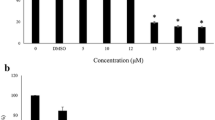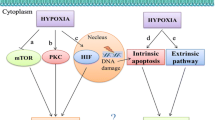Abstract
Apoptosis has been hypothesized to be mediated through the induction of free radicals via oxidative pathway. In this study, we demonstrated the induction of cellular apoptosis by anoxia-hyperoxia shift, but not by anoxia or hyperoxia alone in NIH3T3 cells. The decrement of ROS by anoxia thus appears to be an essential early event leading to apoptosis. G1 arrest was detected in anoxia-treated cells, and postanoxic oxygen recovery could reverse this effect, and induce apoptosis. On analysis of the binding activity of AP-1, we found biphasic induction of binding ability in cells undergoing anoxia-hyperoxia shift. In the early stage of anoxia, a transitional increase of AP-1 binding activity was detected, which was reduced to the minimal levels after 24 h of anoxia. During the period of postanoxic hyperoxia treatment, the binding activity of AP-1 was reinduced and increased remarkably with time up to 24 h. These results were in accordance with the expressions of c-jun and c-fos proteins. Enhancement of poly(ADP-ribosyl)ation activities, especially ADP-ribosylation of histone H1 was detected in post-anoxic hyperoxia-treated cells, and cleavage of PARP and activation of caspase 3 were also observed in post-anoxic hyperoxia (recovery) treated cells, but not in anoxia-treated cells. We propose that the differential induction of c-jun/c-fos (AP-1) gene expressions and sequential activation of PARP activity are essential in anoxia/hyperoxia-induced apoptosis
Similar content being viewed by others
References
Laderoute KR, Webster KA: Hypoxia/reoxygenation stimulates Jun kinase activity through redox signaling in cardiac myocytes. Circ Res 80: 336–344, 1997
Schimizu S, Eguchi Y, Kamiike W, Akao Y, Kosaka H, Hasegawa J, Matsuda H, Tsujimoto Y: Involvement of ICE family proteases in apoptosis induced by reoxygenation of hypoxic hepatocytes. Am J Physiol 271: G949–G958, 1996
Caraceni P, Rosenblum ER, Thiel DH, Borle AB: Reoxygenation injury in isolated rat hepatocytes: Relation to oxygen free radicals and lipid peroxidation. Am J Physiol 266: G799–G806, 1994
Fliss H, Gattinger D: Apoptosis in ischemic reperfused rat myocardium. Circ Res 79: 949–956, 1996
Kerr JF, Wyllie AH, Currie AR: Apoptosis: A basic biological phenomenon with wide-ranging implication in tissue kinetics. Br J Cancer Res 26: 239–257, 1972
Cohen JJ: Apoptosis. Immunol Today 14: 126–130, 1993
Buttke TM, Sandstrom PA: Oxidative stress as a mediator of apoptosis. Immunol Today 15: 7–10, 1994
Halliwell B, Gutteridge JMC: Role of free radicals and catalytic metal ions in human disease: An overview. Meth Enzymol 186: 1–85, 1990
Hockenbery DM, Oltvai ZH, Yin XM, Milliam CL, Korsmeyer SJ: Bcl-2 functions in an antioxidant pathway to prevent apoptosis. Cell 75: 241–251, 1993
Steimnan HM: The Bcl-2 oncoprotein functions as a pro-oxidant. J Biol Chem 270: 3487–3490, 1995
Bissonnette RP, Echeverri F, Mahboubi A, Green DR: Apoptotic cell death induced by c-myc is inhibited by bcl-2. Nature 359: 552–554, 1992
Yonish-Rouach E, Resnitzky D, Lotem J, Sachs L, Kimchi A, Oren M: Wild-type p53 induces apoptosis of myeloid leukemia cells that is inhibited by interleukin-6. Nature 352: 345–347, 1991
Goto S, Matsumoto I, Kamada N, Bui A, Saito T, Findlay M, Pujic Z, Wilce P: The induction of immediate early genes in postischemic and transplanted livers in rats. Its relation to organ survival. Transplantation 58: 840–845, 1994
Estus S, Zaks WJ, Freeman RS, Gruda M, Bravo R, Johnson EMJ: Altered gene expression in neuron during programmed cell death: Identification of c-jun as necessary for neuronal apoptosis. J Cell Biol 127: 1717–1727, 1994
Morgan JI, Curran T: Stimulus-transcription coupling in the nervous system: Involvement of the inducible proto-oncogenes fos and jun. Ann Rev Neurosci 14: 421–451, 1991
Smeyne RJ, Vendrell M, Hayward M, Baker SJ, Miao GG, Schilling K, Robertson LM: Continuous c-fos expression precedes programmed cell death in vivo. Nature 366: 308, 1993
Colotta F, Polentarutti N, Sironi M, Mantovani A: Expression and involvement of c-fos and c-jun protooncogenes in programmed cell death induced by growth factor deprivation in lymphoid cell lines. J Biol Chem 267: 18278–18283, 1992
Yoon YS, Kim JW, Kang KW, Kim YS, Choi KH, Joe CO: Poly(ADPribosyl) ation of histone H1 correlates with internucleosomal DNA fragmentation during apoptosis. J Biol Chem 271: 9129–9134, 1996
Heller B, Wang ZQ, Wagner EF, Radons J, Burkle A, Fehsel K, Kolb H: Inactivation of the poly(ADP-ribose) polymerase gene affects oxygen radical and nitric oxide toxicity in islet cells. J Biol Chem 270: 11176–11180, 1995
Berger NA: Poly(ADP-ribose) in the cellular response to DNA damage. Radiat Res 101: 4–15, 1985
de Murcia G, Menissier-de Murcia J: Poly(ADP-ribose) polymerase: A molecular nick-senser. Trends Biochem Sci 19: 172–176, 1994
Yamamoto H, Uchigata Y, Okamoto H: Steptozotocin and alloxan induce DNA strand breaks and poly(ADP-ribose) synthetase in pancreatic islets. Nature 294: 284–286, 1981
Sims JL, Berger SJ, Berger NA: Poly(ADP-ribose) polymerase inhibits presentive nicotinamide adenine dinucleotide and adenosine 5′-triphosphate pools in DNA damaged cells: Mechanism of stimulation of unscheduled DNA synthesis. Biochemistry 22: 5188–5194, 1983
Stokke T, Erikstein BK, Smedshammer L, Boye E, Steen HB: The retinoblastoma gene product is bound in the nucleus in early G1 phase. Exp Cell Res 204: 147–155, 1993
Shah GM, Poirier D, Duchaine C, Brochu G, Desnoyers S, Lagueux J, Verreault A, Hoflack JC, Kirkl JB, Poirier GG: Methods for biochemical study of poly(ADP-ribose) polymerase. Anal Biochem 227: 1–13, 1995
Desnoyers S, Shah GM, Brochu G, Poirier GG: Erasable blot of poly(ADP-ribose) polymerase. Anal Biochem 218: 470–473, 1994
Grube K, Kupper JH, Burkel A: Direct stimulation of poly(ADP-ribose) polymerase in permeabilized cells by double-stranded DNA oligomers. Anal Biochem 193: 236–239, 1991
Cole RD: Purification and analysis of H1 histones. Meth Enzymol 170: 524–532, 1989
Chen YC, Kuo TC, Lin-Shiau SY, Lin JK: Induction of HSP70 gene expression through modulation of Ca2+ ion and cellular p53 protein by curcumin in colorectal carcinoma cells. Mol Carcinogenesis 17: 224–234, 1996
Caraceni P, Ryu HS, van Thiel DH, Borle AB: Source of oxygen free radicals produced by rat hepatocytes during postanoxic reoxygenation. Biochim Biophys Acta 1268: 249–254, 1995
Wang JF, Jerrells TR, Spitzer JJ: Decreased production of reactive oxygen intermediates is an early event during in vitro apoptosis of rat thymocyte. Free Rad Biol Med 20: 533–542, 1996
Squier MK, Cohen JJ: Cell-mediated cytotoxic mechanisms. Curr Opin Immunol 6: 447–452, 1994
Meikrantz W, Gisselbrecht S, Tam SW, Schlegel R: Activation of cyclin A-dependent protein kinases during apoptosis. Proc Natl Acad Sci USA 91: 3754–3758, 1994
van de Loosdrecht A, Ossenkoppele GJ, Beelen RH, Broekhoven MG, Langenhuijsen MM: Cell cycle specific effects of tumor necrosis factor alpha in monocyte mediated leukemic cell death and the role of beta-2–integrins. Cancer Res 53: 4399–4407, 1993
Nishina H, Sato H, Suzuki T, Sato M, Iba H: Isolation and characterization of fra-2, an additional member of the fos gene family. Proc Natl Acad Sci USA 87: 3619–3623, 1990
Nakabeppu Y, Ryder K, Nathans D: DNA binding activities of three murine Jun proteins: Stimulation by Fos. Cell 55: 907–915, 1988
Malik RK, Roe MW, Blackshear PJ: Epidermal growth factor and other mitogens induce binding of a protein complex to the c-fos serum response element in human astrocytoma and other cells. J Biol Chem 266: 8576–8582, 1991
Brach MA, Gruss HJ, Scott C, Herrmann F: The mitogenic response to tumor necrosis factor alpha requires c-Jun/AP-1. Mol Cell Biol 13: 4284–4290, 1993
Goldstone SD, Lavin MF: Prolonged expression of c-jun and associated activity of the transcription factor AP-1 during apoptosis in a human leukemic cell line. Oncogene 9: 2305–2311, 1994
Gaal JC, Pearson CK: Eukaryotic nuclear ADP-ribosylation reaction. Biochem J 230: 1–18, 1985
Berger NA, Berger SJ, Sudar DC, Distelhort CW: Role of nicotinamide adenine dinucleotide and adenosine triphosphate in glucocorticoid-induced cytotoxicity in susceptible lymphoid cells. J Clin Invest 79: 1558–1563, 1987
Rankin PW, Jacobson EL, Benjamin RC, Moss J, Jacobson MK: Quantitative studies of inhibitors of ADP-ribosylation in vitro and in vivo. J Biol Chem 264: 4312–4317, 1989
Tewari M, Quan L, O'Rourke, Desnoyers S, Zeng Z, Beidler D, Poirier GG, Salvesen GS, Dixit VM: Yama/CPP32 beta, a mammalian homolog of CED-3 is a CrmA-inhibitable protease that cleaves the death substrate poly(ADP-ribose) polymerase. Cell 81: 801–809, 1995
Author information
Authors and Affiliations
Rights and permissions
About this article
Cite this article
Chen, YC., Tsai, SH., Lin-Shiau, SY. et al. Elevation of apoptotic potential by anoxia-hyperoxia shift in NIH3T3 cells. Mol Cell Biochem 197, 147–159 (1999). https://doi.org/10.1023/A:1006941630901
Issue Date:
DOI: https://doi.org/10.1023/A:1006941630901




